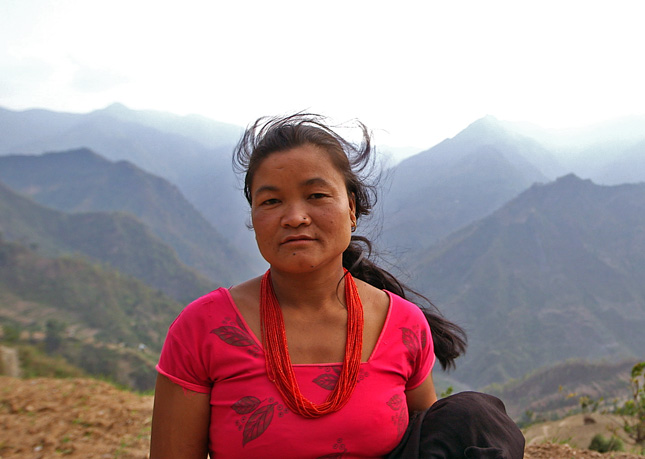-
From One Generation to the Next: New Wilson Center Film Explores Integrated Development in Ethiopia
›June 17, 2015 // By Sean PeoplesOn a warm January afternoon, Tesema Merga, a village elder in Endibir, Ethiopia, surveyed the latest improvements to the long dirt road just outside his house. Eventually this road will be paved, which will bring significant changes to the community.
-
Broken Landscape: Confronting India’s Water-Energy Choke Point
›“We don’t know the reason for the death of fish in downstream villages,” Hamberton Nongtdu, a mine owner from the northeastern Indian state of Meghalaya, told me.
-
In Nepal, Integrating Forest and Family Health Is Improving Lives
›March 24, 2014 // By Sean Peoples
For years, the Chepang people have lived off the land in Nepal’s forested central foothills. Communities cleared trees to start small subsistence farms, harvested the surrounding area for firewood, and eventually moved on after the wood, soil, and water were depleted.
-
Clean Cookstoves and PHE Champions on Tanzania’s Northern Coast
›As our ferry slowly made its way across the Pangani River along the northern coast of Tanzania, I sat next to a woman whose child held her hand tightly. The boy and I exchanged smiles, but we mainly admired the view. The late morning sun was behind us as the royal blue river met the cloudless sky.
-
PHE Is One Great Idea That Won’t Be On the Rio Agenda, Says Roger-Mark De Souza
›October 17, 2011 // By Sean Peoples“I am now serving as an example to other women in the community because I am not having any more children. I have received training in sustainable agricultural practices, I’m generating income, and I’m educating others,” said Berhane Ferkade, an Ethiopian farmer, to Population Action International’s Roger-Mark De Souza earlier this year. The 39-year-old mother of 11 become one of the community’s model farmers after working with LEM Ethiopia – a local population, health, and environment (PHE) development organization.
-
Watch: Population, Health, and Environment in Ethiopia
›Severely eroded and deforested, Ethiopia’s land is increasingly turning to desert, due to the country’s high population growth, unsustainable land use, and lack of land ownership. Featuring footage from my trip to Ethiopia last year, this video looks at the efforts of two projects to combat these devastating trends by meeting the country’s complex challenges with integrated solutions.
Ethiopia’s population is estimated at 85 million. Since 1900, the country has grown by nearly 74 million people, and the United Nations predicts this rapid growth will continue, reaching nearly 120 million people by 2025.
“Family planning is very crucial” to sustainable development, said Gebrehiwot Hailu of the Relief Society of Tigray (REST), located in the northern region of Tigray. “If the family has more children… he can’t feed them properly, he can’t send the children to school, because there is a food gap in the household.” REST uses a watershed planning model jointly developed by the community, health workers, and government agencies.
Realizing there is no silver bullet to development, projects like REST integrate population, health, and environment (PHE) programs to engage these challenges from all angles.
The Ethio Wetlands and Natural Resource Association (EWNRA), located in Ethiopia’s Wichi watershed, uses a combination of techniques to restore the watershed, create alternative livelihoods, strengthen health systems, and improve reproductive health.
“Through this integrated watershed intervention, the wetland is regaining its natural situation,” Shewaye Deribe of EWNRA told me. “The communities with their own bylaws, with their own watershed committee, with their own organization… are protecting these remaining forest patches.”
Sources: Population Reference Bureau. -
Pop-Up Video: Cable News Covers PHE Connections
›It was a bit of a shock to hear population-environment connections being discussed on television, including the Most Trusted Name in News (aka Jon Stewart’s Daily Show), as well as CNN’s Amanpour, late last month.
-
VIDEO – Joshua Busby on Climate Change and African Political Stability
›April 6, 2010 // By Sean Peoples“It is not enough to say that Ethiopia is vulnerable,” says Joshua Busby, an assistant professor at the LBJ School of Public Affairs at the University of Texas at Austin. Also necessary is “which parts of Ethiopia are vulnerable and why.” Busby is part of the Department of Defense-funded Climate Change and African Political Stability (CCAPS) project. Part of the Minerva Research Initiative, CCAPS is a multi-year, multi-institution effort to diagnose and assess the causal connections between climate change and security consequences.
In order to diagnose these relationships, CCAPS will use “geographic information systems to map sub-national vulnerability to climate change,” Busby says. Maps will not only include physical exposure to climate change, but also detailed social, household, and community level indicators and broader factors of politics, governance, and demography.
Although only in the first year of the project, Busby describes the initial achievements CCAPS has made in mapping specific vulnerability areas throughout western Ethiopia, the Democratic Republic of the Congo, and Nigeria. In the next few years, the CCAPS project will continue to map region-specific areas of vulnerability on the African continent and will provide policymakers with the tools to improve foreign assistance flows in areas of high vulnerability.
Showing posts by Sean Peoples.




